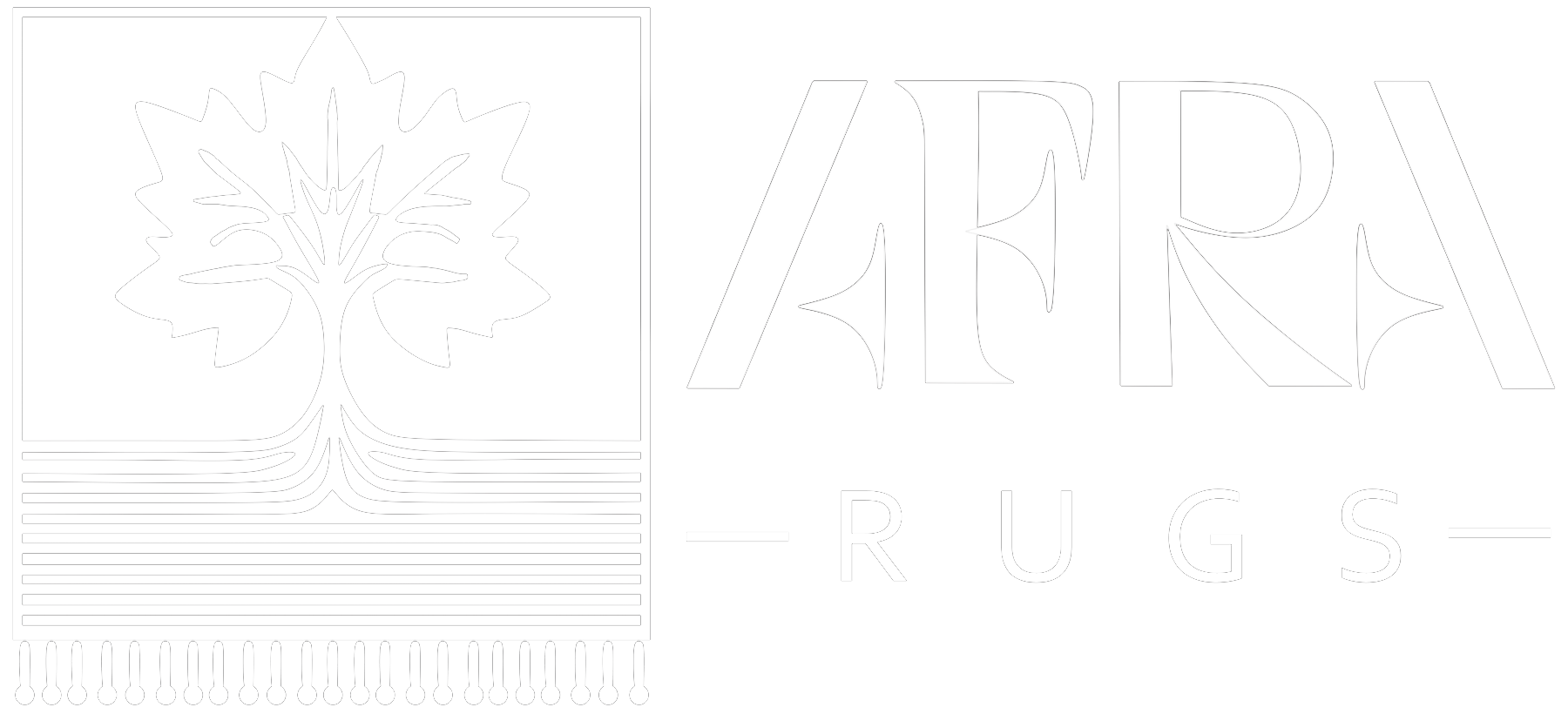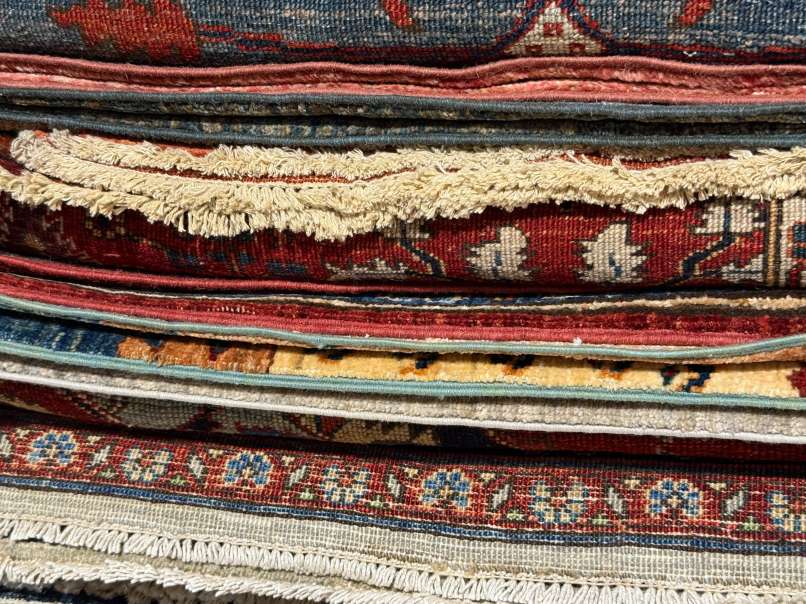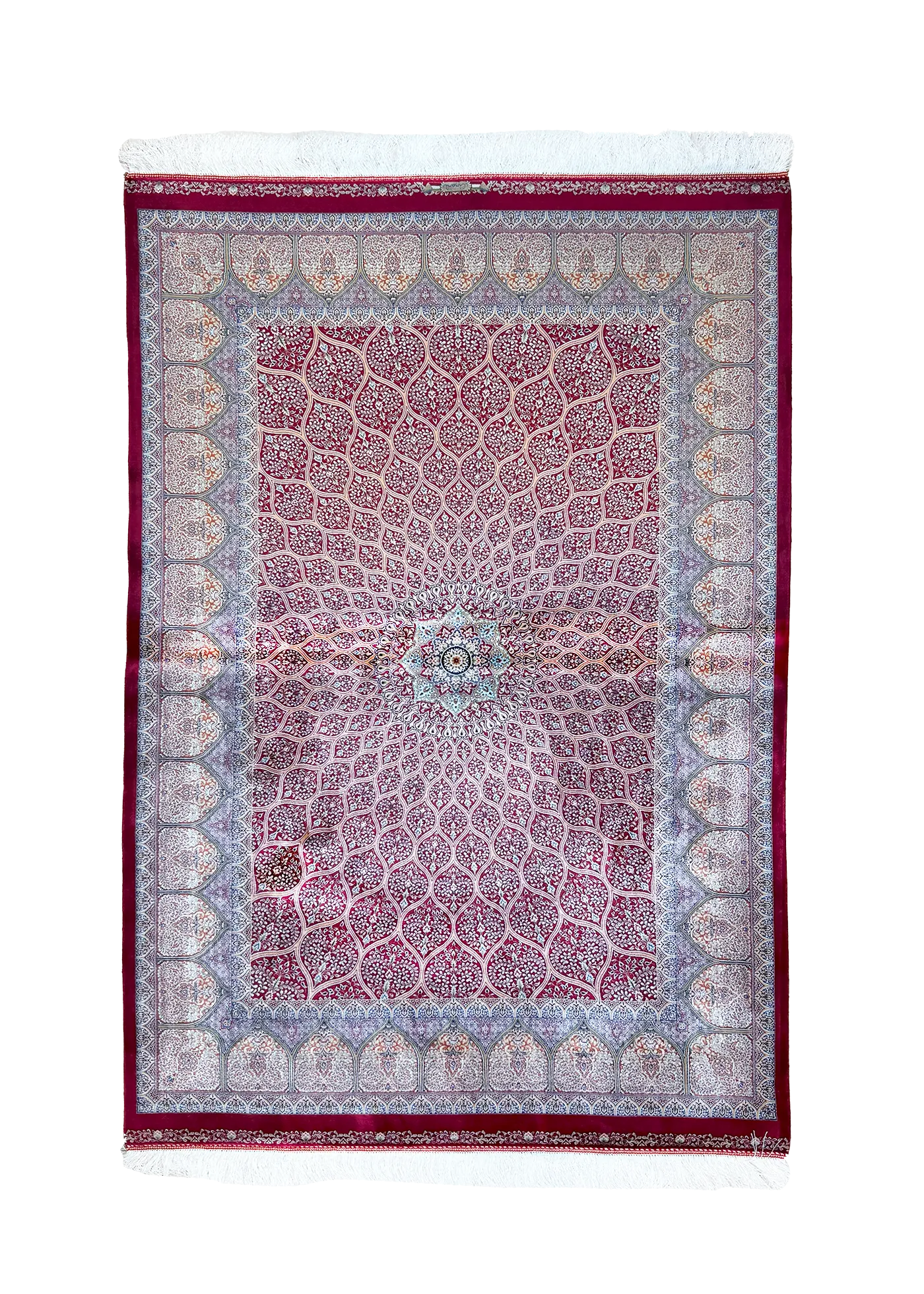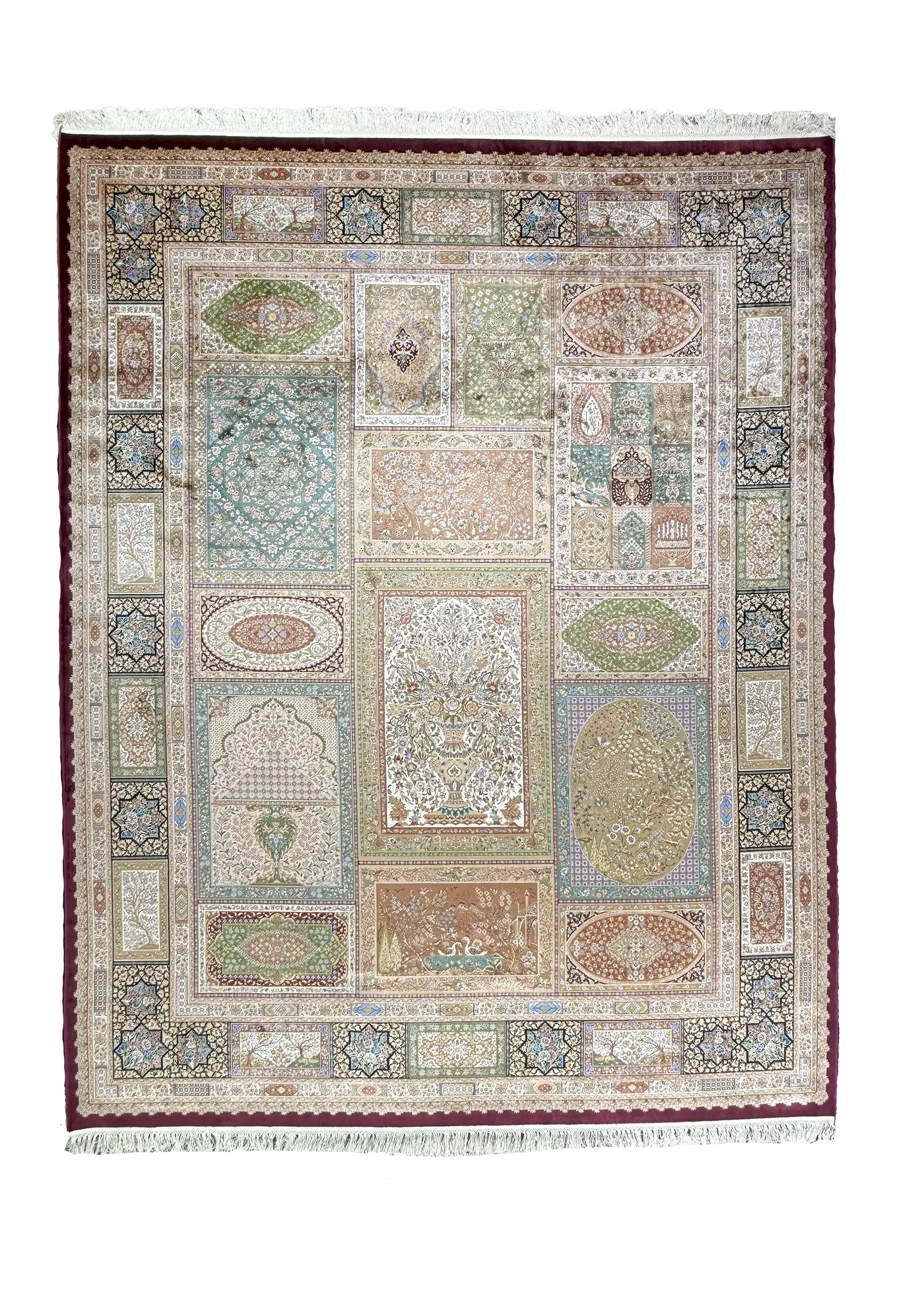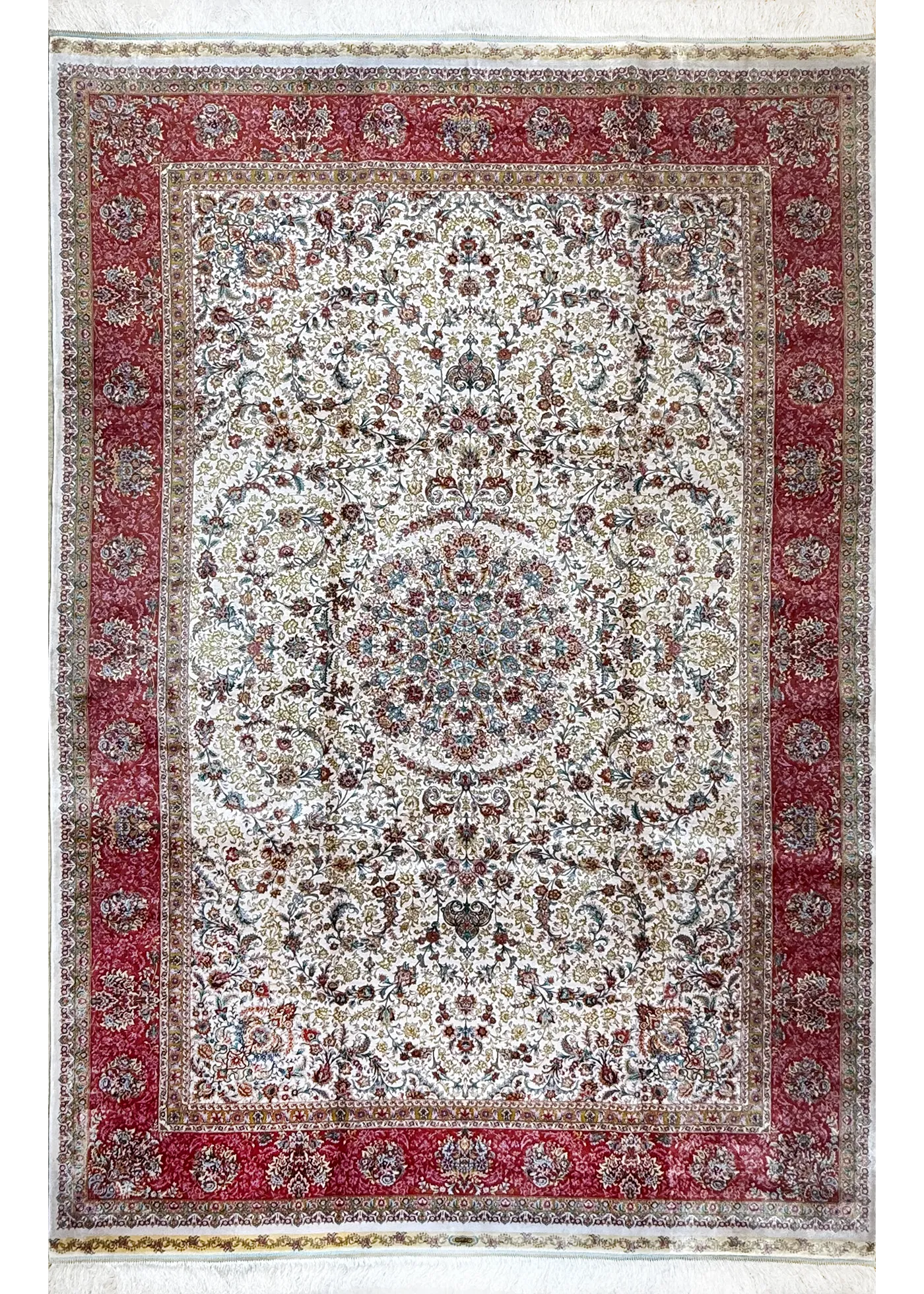Exploring the Rich Diversity of Types of Persian Rugs by Region
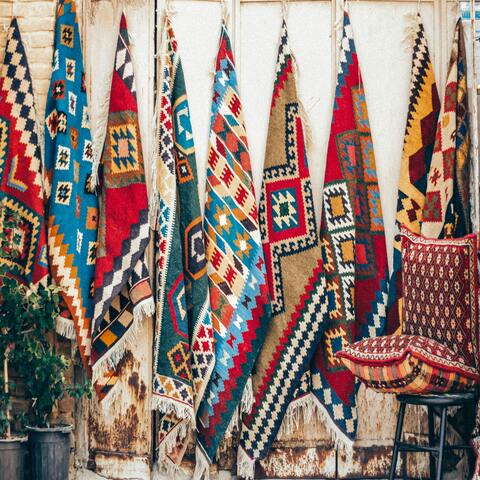
- 1 Red and Blue Persian Rug Vanda Pattern 5 x 8
- 2 Introduction: Every Rug Tells a Story
- 3 The Birth of Persian Weaving
- 4 The Heart and Soul of Regional Rugs
- 5 The Symbolism Woven in Every Thread
- 6 FAQ: Common Questions About Persian Rugs
- 7 Caring for a Timeless Treasure
- 8 Conclusion: A Living Tapestry of Culture
Discover the timeless artistry behind the many types of Persian rugs by region. From Kashan rugs to Tabriz and Isfahan, explore their unique heritage at Afra Rugs.
Introduction: Every Rug Tells a Story
A Persian rug isn’t just a piece of décor. Every Persian rug tells a story through color, pattern, and patience. Each design carries the soul of the region that shaped it. From the cool blues of Isfahan to the deep reds of Kashan rugs, every knot has a meaning.
Weavers have passed their craft through generations _ from parents to children, from one village to the next. Together, they’ve created one of the most admired crafts in the world.
At Afra Rugs, we honor that story. Our Traditional Persian Rugs Collection captures the timeless beauty of regional designs _ inspired by history, woven for modern homes.
This article will take you on a journey through the types of Persian rugs. Each region shows its own character _ from the bold shapes of Heriz to the soft pastels of Kerman. By the end, you’ll understand why these rugs are more than floor coverings _ they’re living art.
The Birth of Persian Weaving
The art of Persian weaving began thousands of years ago. History detectives discovered rug pieces more than 2,500 years old. They reveal that Persians were among the first to create detailed art from wool and silk.
At first, rugs were practical _ protection from cold floors or desert winds. But as Persian culture grew, so did the beauty of its rugs. Kings and poets began to celebrate them. Palaces, mosques, and even simple homes displayed rugs as signs of pride, creativity, and faith.
Different towns developed their own ways of weaving. Geography, climate, and culture shaped everything _ from color choice to pattern. Researchers have found rug fragments that are more than 2,500 years old. These discoveries show that Persians were among the first to weave wool and silk into detailed works of art.
Table: Common Types of Persian Rugs by Region
| Region | Signature Design | Color Palette | Knot Density | Key Features |
|---|---|---|---|---|
| Tabriz | Medallions, floral vines | Red, navy, ivory | High | Detailed, balanced patterns |
| Kashan | Floral medallions, vines | Deep red, blue, ivory | Very high | Elegant, royal feel |
| Isfahan | Gardens, arabesques | Light blue, gold, ivory | Very high | Precise and architectural |
| Kerman | Flowers, trees, paisley | Rose, turquoise, cream | Medium-high | Soft, romantic colors |
| Heriz | Bold geometric medallions | Rust, navy, ivory | Medium | Tribal strength, bold shapes |
| Nain | Floral scrolls | Ivory, beige, blue | Very high | Subtle, calm elegance |
| Qom | Mini motifs, calligraphy | Cream, gold, green | Extremely high | Fine silk details |
Table: Overview of regional types of Persian rugs
Each city tells a different story. The people of Tabriz loved geometry and order. Weavers in Kashan, on the other hand, filled their rugs with flowers and vines to show the beauty of nature. Together, these cities wove the heart of Persian identity into fabric.
The Heart and Soul of Regional Rugs
Let’s take a closer look at the regions that shaped the world’s most admired carpets.
Tabriz: A City of Master Weavers
Tabriz, in northwestern Persia, has been a weaving center for over 500 years. Weavers in Tabriz create rugs with symmetrical patterns, detailed medallions, and floral designs. The colors _ red, navy, and ivory _ reflect both warmth and depth.
What makes Tabriz unique is precision. Weavers often used double knots for durability. These rugs feel balanced, like fine architecture.
A Tabriz rug brings a sense of order and grace to any room. This rug shows how Persian craftsmanship blends beauty and purpose.
Kashan Rugs: The Epitome of Persian Elegance
When people discuss royal beauty, they often mean Kashan rugs. Kashan, in central Persia, rose to fame during the Safavid dynasty for its beautiful rug designs.
These traditionally Persian rugs feature deep red backgrounds, central medallions, and ivory accents. The patterns show flowing floral and curving designs. They are graceful, never harsh, and give each rug the feeling of a blooming garden frozen in time.
Historically, Kashan rugs decorated palaces and embassies. Even today, collectors prize them for their refinement. Weavers carefully use natural dyes in deep reds and blues, making the colors glow softly.
The intricate design elements reflect centuries of skillful rug weaving. A Kashan rug doesn’t shout for attention _ it simply radiates elegance and tradition.
Isfahan: Precision and Poetry
Isfahan rugs are among the most detailed in the world. Weavers take inspiration from the city’s mosques, bridges, and gardens. They create traditionally Persian rugs with meticulous geometrical and medallion designs.
Silk outlines add shimmer to every curve. Dark blues, pale blue, ivory, and gold dominate the palette, creating a calm and elegant effect.
Looking at these rugs is like reading poetry _ each line is exact, and each design element tells a story. The mix of geometric patterns and floral motifs highlights the harmony in Persian artistry. In short, Isfahan rugs represent the height of craftsmanship in types of Persian rugs.
Kerman: Soft Colors and Romantic Spirit
Kerman, in southeastern Persia, tells a softer story. Its weavers favor light, romantic colors like rose, turquoise, and cream, often using natural dyes. Kerman rugs showcase flowing patterns that depict gardens, flowers, or animals _ common design elements symbolizing love, peace, and growth.
These rugs have a dreamy quality. Their geometrical designs are looser, more fluid, almost like watercolor paintings. The combination of soft reds and blues gives each piece warmth and charm. If a Tabriz rug feels architectural, a Kerman rug feels emotional _ a true expression of feeling through rug weaving.
Heriz: Rugged Beauty
In the mountains of northwest Persia, the Heriz region produces some of the most durable types of Persian rugs. Heriz rugs are different from the delicate florals of Isfahan or Kashan. They stand out with bold, angular geometric patterns and strong lines.
Known for their geometrical designs and earthy tones _ rust, indigo, ivory _ these rugs have a tribal, rustic feel. While the knot count may be lower, the cotton foundation and sturdy weave make them long-lasting. Heriz rugs speak of endurance and strength, perfect for homes seeking a statement piece with history and presence.
Nain: Grace in Simplicity
Nain rugs offer a quiet contrast to Heriz. Calm, elegant, and minimalist, Nain weavers accent their ivory backgrounds with soft blue and beige. Their subtle geometrical designs and careful rug weaving give them a refined look.
Nain rugs have some of the highest knot densities of all traditionally Persian rugs. This makes them fine, delicate, and visually stunning. Even the simplest patterns _ including small medallions or floral motifs _ leave a lasting impression.
Qom: The Art of Silk
Qom, one of the youngest weaving centers, produces pure silk types of Persian rugs. These rugs serve as devotional works as much as decorative ones. They combine delicate medallion designs, floral elements, and sometimes tree of life motifs.
Colors like cream, gold, and green shimmer with light thanks to natural dyes, creating a luminous quality. Each Qom rug reflects careful rug weaving and artistic devotion. More than a floor covering, a Qom rug is a meditation _ blending art, faith, and the beauty of Persian tradition.
The Symbolism Woven in Every Thread
Every type of Persian rug is filled with meaning. The patterns are not random; they are symbols that express ideas, emotions, and beliefs.
- Medallions often represent the universe or spiritual unity.
- Flowers and vines symbolize growth, beauty, and paradise.
- Trees stand for life and endurance.
- The boteh (paisley) represents eternity and protection.
For centuries, these designs reflected Persian culture’s love of nature and philosophy. Weavers often depict gardens on rugs, inspired by Persian poetry that imagines paradise as a garden.
That’s what makes Persian rugs different from machine_made ones _ they carry emotion. You don’t just see a design; you feel a message.
List: Top Features of Traditional Types of Persian Rugs
- Regional Identity _ Each rug mirrors its homeland’s landscape and heritage.
- Symbolism _ Designs tell stories of life, faith, and nature.
- Color Harmony _ Natural dyes give deep, lasting hues.
- Technique _ Knotting methods vary across regions, giving each rug its own personality.
- Texture and Material + From silk softness in Qom to sturdy wool in Heriz.
- Cultural Continuity – Patterns passed through generations remain alive today.
These qualities make Persian rugs more than collectibles _ they’re family stories woven by hand.
Persian Rugs in the Modern World
Persian rugs are ancient treasures, yet their charm remains timeless. Even in modern homes, they feel right at home, blending seamlessly with contemporary furniture, minimalist layouts, or eclectic decor. Designers and homeowners appreciate how these rugs balance tradition, artistry, and functionality. They turn any space into a statement of culture and elegance.
Modern Persian style rugs often honor the classic patterns developed over centuries, but they also embrace innovation. Many use updated colors, subtle gradients, or new materials that make them lighter, softer, and easier to care for.
Some rugs keep the traditional central medallion and floral motifs. Others experiment with geometric patterns, bold accent colors, or simplified designs that fit modern interiors. This mix helps a home feel connected to history while still fitting modern style.
At Afra Rugs, we celebrate this harmony of old and new. Our [Traditional Persian Rugs Collection] preserves the essence of historical craftsmanship. The designs echo the elegance of Kashan, Isfahan, and Kerman rugs.
Every rug tells a story through time-honored techniques and floral patterns. The carefully chosen colors _ deep reds, soft blues, and ivory accents _ bring the design to life.
Meanwhile, our [Modern Persian Rugs Collection] brings a fresh perspective. These rugs draw inspiration from classic Persian artistry but update it for today’s spaces. Designers love using these rugs to bring the richness of Persian heritage into a living room, bedroom, or office.
At the same time, the rugs never overwhelm a modern aesthetic. Soft pastels, neutral tones, and bold pops of color bring the spirit of Persia to life. At the same time, they adapt beautifully to contemporary tastes.
Bringing a Persian style rug into your home is more than a design choice _ it’s a connection to a living tradition. Each rug carries the personality of its region. Every medallion tells a subtle story, and skilled weavers turn fibers into art.
When you place one on your floor, you invite a piece of history, culture, and artistry into your everyday life. This reminds us that beauty and craftsmanship transcend time, fitting effortlessly into both classic and modern interiors.
Whether you choose the timeless grace of a traditional rug or the fresh style of a modern piece, these rugs bridge centuries. They bring warmth, character, and the quiet elegance of Persian artistry into your home. Each step across a rug takes you through history. This tactile reminder shows that Persian rug weaving is as alive today as it was hundreds of years ago.
FAQ: Common Questions About Persian Rugs
1. What are the main types of Persian rugs?
The main types of Persian rugs come from regions like Tabriz, Isfahan, Kashan, Kerman, Nain, Heriz, and Qom. Each has a different look and feel shaped by its geography and culture.
2. What makes Kashan rugs so admired?
Kashan rugs strike a perfect balance of beauty and precision. Their red and blue designs are graceful, their weave dense and durable. They feel royal yet comforting.
3. Wondering which region your rug comes from?
Look at the colors and patterns. Tabriz uses medallions and symmetry. Kerman shows soft pastels. Heriz features sharp, bold geometry. Kashan loves floral motifs and rich reds.
4. Do artisans continue to make Persian rugs today?
Yes! Many artisans still weave Persian rugs using traditional techniques. Some modern rugs, including those at Afra Rugs, take inspiration from these classic techniques while using contemporary materials.
5. Do Persian rug patterns carry special meanings?
Absolutely. Every flower, line, and symbol means something _ love, growth, faith, eternity. That’s why people often call Persian rugs ‘woven poems.’
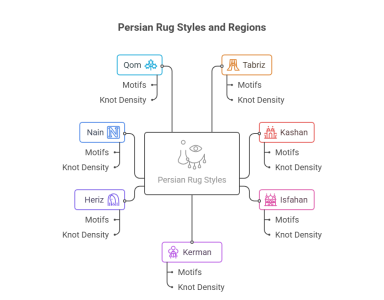
Caring for a Timeless Treasure
Owning a Persian rug means caring for something precious. Even modern versions deserve attention.
Here are a few simple care tips:
- Vacuum gently _ avoid using high suction to protect fibers.
- Rotate the rug every few months to prevent uneven wear.
- Avoid direct sunlight to preserve colors.
- Professional cleaning every couple of years keeps it fresh and bright.
Treating your rug with care ensures it lasts for decades _ maybe even generations.
Conclusion: A Living Tapestry of Culture
Types of Persian rugs showcase some of the most remarkable artistry in human history. Each region _ from bold Heriz to graceful Kashan rugs _ adds a voice to the chorus of Persian creativity.
They teach us that beauty can come from patience, and art can live in the simplest daily objects.
At Afra Rugs, we believe every home deserves a touch of that timeless artistry. Explore our Traditional Persian Rugs Collection. These designs, born centuries ago, still inspire comfort and connection today.
Because a rug is more than décor _ it’s a story underfoot.
